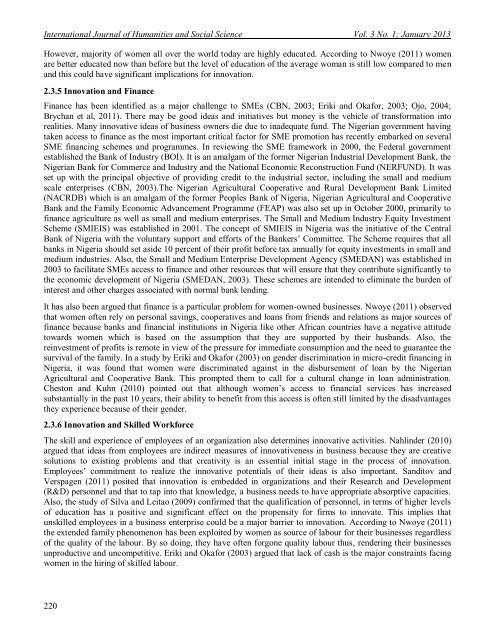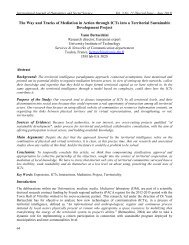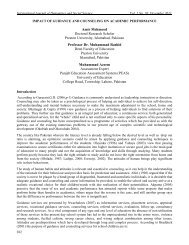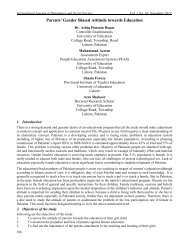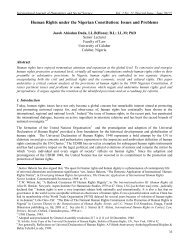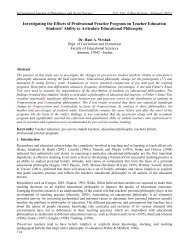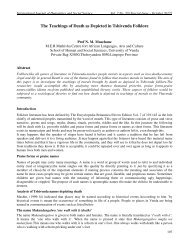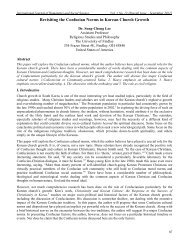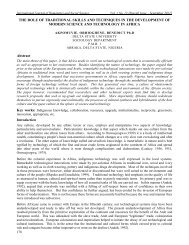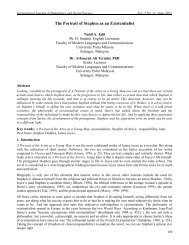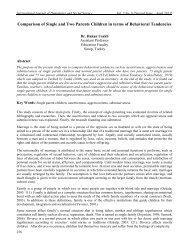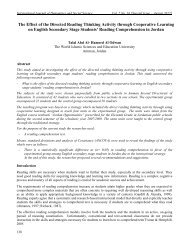Gender Influence on Access to Innovation Resources in Nigeria
Gender Influence on Access to Innovation Resources in Nigeria
Gender Influence on Access to Innovation Resources in Nigeria
Create successful ePaper yourself
Turn your PDF publications into a flip-book with our unique Google optimized e-Paper software.
Internati<strong>on</strong>al Journal of Humanities and Social Science Vol. 3 No. 1; January 2013<br />
However, majority of women all over the world <strong>to</strong>day are highly educated. Accord<strong>in</strong>g <strong>to</strong> Nwoye (2011) women<br />
are better educated now than before but the level of educati<strong>on</strong> of the average woman is still low compared <strong>to</strong> men<br />
and this could have significant implicati<strong>on</strong>s for <strong>in</strong>novati<strong>on</strong>.<br />
2.3.5 Innovati<strong>on</strong> and F<strong>in</strong>ance<br />
F<strong>in</strong>ance has been identified as a major challenge <strong>to</strong> SMEs (CBN, 2003; Eriki and Okafor, 2003; Ojo, 2004;<br />
Brychan et al, 2011). There may be good ideas and <strong>in</strong>itiatives but m<strong>on</strong>ey is the vehicle of transformati<strong>on</strong> <strong>in</strong><strong>to</strong><br />
realities. Many <strong>in</strong>novative ideas of bus<strong>in</strong>ess owners die due <strong>to</strong> <strong>in</strong>adequate fund. The <strong>Nigeria</strong>n government hav<strong>in</strong>g<br />
taken access <strong>to</strong> f<strong>in</strong>ance as the most important critical fac<strong>to</strong>r for SME promoti<strong>on</strong> has recently embarked <strong>on</strong> several<br />
SME f<strong>in</strong>anc<strong>in</strong>g schemes and programmes. In review<strong>in</strong>g the SME framework <strong>in</strong> 2000, the Federal government<br />
established the Bank of Industry (BOI). It is an amalgam of the former <strong>Nigeria</strong>n Industrial Development Bank, the<br />
<strong>Nigeria</strong>n Bank for Commerce and Industry and the Nati<strong>on</strong>al Ec<strong>on</strong>omic Rec<strong>on</strong>structi<strong>on</strong> Fund (NERFUND). It was<br />
set up with the pr<strong>in</strong>cipal objective of provid<strong>in</strong>g credit <strong>to</strong> the <strong>in</strong>dustrial sec<strong>to</strong>r, <strong>in</strong>clud<strong>in</strong>g the small and medium<br />
scale enterprises (CBN, 2003).The <strong>Nigeria</strong>n Agricultural Cooperative and Rural Development Bank Limited<br />
(NACRDB) which is an amalgam of the former Peoples Bank of <strong>Nigeria</strong>, <strong>Nigeria</strong>n Agricultural and Cooperative<br />
Bank and the Family Ec<strong>on</strong>omic Advancement Programme (FEAP) was also set up <strong>in</strong> Oc<strong>to</strong>ber 2000, primarily <strong>to</strong><br />
f<strong>in</strong>ance agriculture as well as small and medium enterprises. The Small and Medium Industry Equity Investment<br />
Scheme (SMIEIS) was established <strong>in</strong> 2001. The c<strong>on</strong>cept of SMIEIS <strong>in</strong> <strong>Nigeria</strong> was the <strong>in</strong>itiative of the Central<br />
Bank of <strong>Nigeria</strong> with the voluntary support and efforts of the Bankers’ Committee. The Scheme requires that all<br />
banks <strong>in</strong> <strong>Nigeria</strong> should set aside 10 percent of their profit before tax annually for equity <strong>in</strong>vestments <strong>in</strong> small and<br />
medium <strong>in</strong>dustries. Also, the Small and Medium Enterprise Development Agency (SMEDAN) was established <strong>in</strong><br />
2003 <strong>to</strong> facilitate SMEs access <strong>to</strong> f<strong>in</strong>ance and other resources that will ensure that they c<strong>on</strong>tribute significantly <strong>to</strong><br />
the ec<strong>on</strong>omic development of <strong>Nigeria</strong> (SMEDAN, 2003). These schemes are <strong>in</strong>tended <strong>to</strong> elim<strong>in</strong>ate the burden of<br />
<strong>in</strong>terest and other charges associated with normal bank lend<strong>in</strong>g.<br />
It has also been argued that f<strong>in</strong>ance is a particular problem for women-owned bus<strong>in</strong>esses. Nwoye (2011) observed<br />
that women often rely <strong>on</strong> pers<strong>on</strong>al sav<strong>in</strong>gs, cooperatives and loans from friends and relati<strong>on</strong>s as major sources of<br />
f<strong>in</strong>ance because banks and f<strong>in</strong>ancial <strong>in</strong>stituti<strong>on</strong>s <strong>in</strong> <strong>Nigeria</strong> like other African countries have a negative attitude<br />
<strong>to</strong>wards women which is based <strong>on</strong> the assumpti<strong>on</strong> that they are supported by their husbands. Also, the<br />
re<strong>in</strong>vestment of profits is remote <strong>in</strong> view of the pressure for immediate c<strong>on</strong>sumpti<strong>on</strong> and the need <strong>to</strong> guarantee the<br />
survival of the family. In a study by Eriki and Okafor (2003) <strong>on</strong> gender discrim<strong>in</strong>ati<strong>on</strong> <strong>in</strong> micro-credit f<strong>in</strong>anc<strong>in</strong>g <strong>in</strong><br />
<strong>Nigeria</strong>, it was found that women were discrim<strong>in</strong>ated aga<strong>in</strong>st <strong>in</strong> the disbursement of loan by the <strong>Nigeria</strong>n<br />
Agricultural and Cooperative Bank. This prompted them <strong>to</strong> call for a cultural change <strong>in</strong> loan adm<strong>in</strong>istrati<strong>on</strong>.<br />
Chest<strong>on</strong> and Kuhn (2010) po<strong>in</strong>ted out that although women’s access <strong>to</strong> f<strong>in</strong>ancial services has <strong>in</strong>creased<br />
substantially <strong>in</strong> the past 10 years, their ability <strong>to</strong> benefit from this access is often still limited by the disadvantages<br />
they experience because of their gender.<br />
2.3.6 Innovati<strong>on</strong> and Skilled Workforce<br />
The skill and experience of employees of an organizati<strong>on</strong> also determ<strong>in</strong>es <strong>in</strong>novative activities. Nahl<strong>in</strong>der (2010)<br />
argued that ideas from employees are <strong>in</strong>direct measures of <strong>in</strong>novativeness <strong>in</strong> bus<strong>in</strong>ess because they are creative<br />
soluti<strong>on</strong>s <strong>to</strong> exist<strong>in</strong>g problems and that creativity is an essential <strong>in</strong>itial stage <strong>in</strong> the process of <strong>in</strong>novati<strong>on</strong>.<br />
Employees’ commitment <strong>to</strong> realize the <strong>in</strong>novative potentials of their ideas is also important. Sandi<strong>to</strong>v and<br />
Verspagen (2011) posited that <strong>in</strong>novati<strong>on</strong> is embedded <strong>in</strong> organizati<strong>on</strong>s and their Research and Development<br />
(R&D) pers<strong>on</strong>nel and that <strong>to</strong> tap <strong>in</strong><strong>to</strong> that knowledge, a bus<strong>in</strong>ess needs <strong>to</strong> have appropriate absorptive capacities.<br />
Also, the study of Silva and Leitao (2009) c<strong>on</strong>firmed that the qualificati<strong>on</strong> of pers<strong>on</strong>nel, <strong>in</strong> terms of higher levels<br />
of educati<strong>on</strong> has a positive and significant effect <strong>on</strong> the propensity for firms <strong>to</strong> <strong>in</strong>novate. This implies that<br />
unskilled employees <strong>in</strong> a bus<strong>in</strong>ess enterprise could be a major barrier <strong>to</strong> <strong>in</strong>novati<strong>on</strong>. Accord<strong>in</strong>g <strong>to</strong> Nwoye (2011)<br />
the extended family phenomen<strong>on</strong> has been exploited by women as source of labour for their bus<strong>in</strong>esses regardless<br />
of the quality of the labour. By so do<strong>in</strong>g, they have often forg<strong>on</strong>e quality labour thus, render<strong>in</strong>g their bus<strong>in</strong>esses<br />
unproductive and uncompetitive. Eriki and Okafor (2003) argued that lack of cash is the major c<strong>on</strong>stra<strong>in</strong>ts fac<strong>in</strong>g<br />
women <strong>in</strong> the hir<strong>in</strong>g of skilled labour.<br />
220


